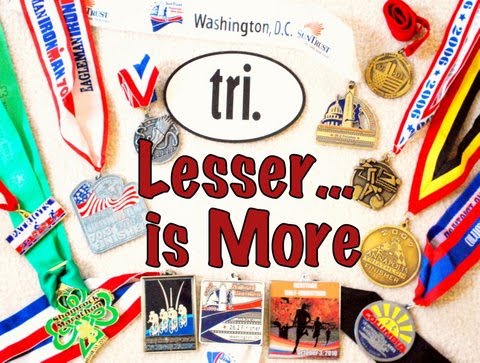My intent of this series is to document my thoughts (as of today) about what I know and how it is influencing my training moving forward. I have read quite a bit recently, as I mentioned in my previous post. After having the time to think about all of the information and map it to myself, I have developed a few principles that I plan to follow and believe apply to most others. Each principle consists of a section below.
Part 1
Part 2
Part 3
In this last part, I'd like to sum up my ramblings. I felt compelled to write this, partially for myself, but also for any other people that are willing to look beyond the frequent advice columns we receive daily. I continue to read one article after another, and am left at the end wondering, "How is this going to help someone?". My hope is that the logic and approach that is stressed throughout this series forces people to rethink their approach to training. Maybe it will, maybe it won't. Like I said initially, we are all different. And while this specific approach may not fit the type of training you need, the concept of evaluating ourselves, questioning what we read, and considering our long term goals can apply to anyone.
Going back to the beginning, my approach consists of the following:
- Assessing your endurance background: What are your strengths/weaknesses with regard to sport? Where can you find opportunities for improvement? What went well last year? What would you change? These are the types of questions you should be asking yourself as you look toward the upcoming season. Figure out where you are today, where you want to be tomorrow, and assess what it will take to (realistically) get there. You may have a far reaching goal that cannot realistically be met within the year. Figure out what it takes to get there and plan to improve over time. You've got to have the patience to get there. Shortcut approaches don't typically result in long term benefits.
- Building the base: It is my belief that most people do not have a sufficient base to warrant the types of workouts they do. Look at the training guidance of most experts and you'll find that only about 15% of your total weekly running should be speedwork. Why then, do most people go off and run tempos, repeats, intervals, etc? Track your mileage and be careful of doing too much stressful activity without the base to support it. Build a very large base and not only will your fitness and speed improve, but it will allow you to recover more efficiently when you've reached the appropriate time to begin adding those types of workouts into your program. But only AFTER you have built the base. Along the lines of a far reaching goal, only a very large base will ensure you achieve that. Otherwise you risk, delayed soreness impacting future workouts and ultimately, injury.
- Long Term Versus Short Term: Don't quit building the base, just so you can peak for a non-important race only half way through your plan or to your goal. Keep your eye on the prize and continue to build to your goal. Focusing on the short term will only keep you from achieving that long term goal. Don't settle for instant gratification if it is going to derail your long term plans. Similarly, you can use short term goals to guide your long term goals. If you make short term goals in line with your long term goals (e.g. improve my average pace at average heart rate of 140 by 5 seconds per mile within 2 months), then it can help keep the level of motivation there. Just don't let those pesky short term goals get in the way of the long term perspective. Use baseline tests to measure short term progress as you build to your long term goals.
- Each Athlete Is Different: You've read article after article to learn how to get faster. But how is it that one strategy can be the best approach for everyone? Take what you read with the understanding that everyone is different. Is stressful training appropriate to introduce to your body yet? Does it align with your goals? Understand yourself, what your needs are, and how the training you are considering will affect your body. I love reading about different training approaches. Some of them apply to my training right now, others don't. But I read it all with the understanding that everyone is different.
- Strength and Maintenance: In order to stay healthy through all this stress you put on your body, you have to incorporate some type of strength and maintenance program. It will keep your muscles balanced and loose. Repetitive motion such as running focuses on a few of the lower leg muscles, but not all of them. Adding in some exercises to hit them all will ensure you don't develop muscle imbalances, forcing one to compensate for the other. This limits the risk of injury and lets you focus on what you do best - run.
- Running Form: Running form tends to get a lot of attention these days, and it should. It is critical to maintaining efficient form, allowing you to maximize the fitness you've built. My focus on running form is mainly in the area of maintaining your center of gravity under your body. You do this by ensuring you don't over stride, causing a harmful heel strike with excessive amounts of force to your lower leg. Keep your center of gravity under your body and you can run using which ever form seems natural.
So that's it...my brain dump is over. Feel free to discuss, because I'm always interested in hearing other people's thoughts. What is your training approach/methodology toward endurance?

1 comment:
nicely done. Thanks for sharing your thoughts... now to digest and see wher I can apply it.
Post a Comment